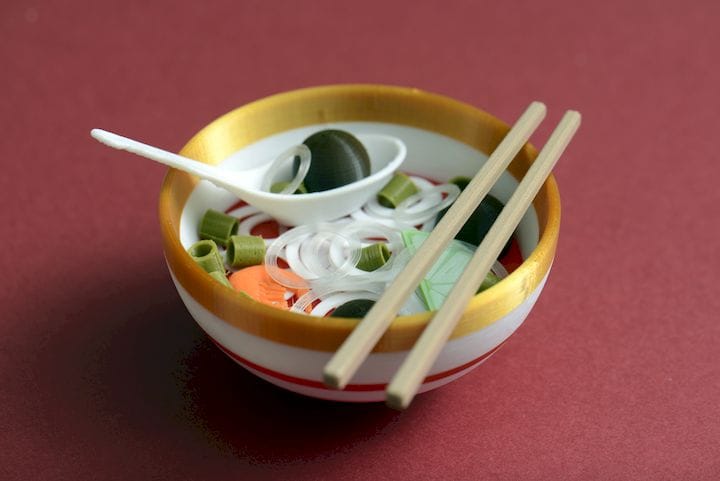![Highly realistic 3D printed pho [Source: Eric Au]](https://fabbaloo.com/wp-content/uploads/2020/05/macpho-ov_result_img_5eb099b285380.jpg)
This week’s selection is the uncannily realistic “Mac Pho” by maker Eric Au.
Au is a Canadian maker who creates all manner of interesting products through his business, Skinth Solutions. Many of his products are storage solutions, such as wallets or backpacks, quite different from 3D printing.
“Mac Pho” is a 3D printed representation of a bowl of Pho, a delicious vietnamese noodle soup that aficionados seek everywhere. It’s composed of a number of simple-geometry parts that due to their arrangement and coloring appear startlingly realistic.
You’re probably wondering why this piece is named “Mac Pho”, as I was. Au explains:
“The Mac Pho is a custom built PC tower that runs Mac OSX via a little software trickery. Having been an Apple user for well over 15 years, I’ve grown to enjoy the working environment. However, there are currently not any offerings that make me want to spend that much money on already outdated hardware. My last iMac was from 2010 and it only started to show its age when tried to run Autodesk Fusion 360 on it and the video card did not have enough memory to render the spinning models. So I built my own computer for about 1/4 the cost, and it’s specs rival a Mac Pro.
Mac Pro – Fake Mac – Mac Faux – Mac Pho. That’s where my brain went. The computer case is not very Apple at all, but I enjoy seeing the components of the computer so I decided it needed a little accent.”
And:
“The inspiration for this was pulled from the Japanese tradition of making fake but incredibly realistic food samples that would be displayed outside of the restaurant.”
![The Mac Pho 3D print sitting inside the actual Mac Pho computer [Source: Eric Au]](https://fabbaloo.com/wp-content/uploads/2020/05/image-asset_img_5eb099b3040eb.jpg)
Aha, so Mac Pho is a kind of branding for his homebuilt Mac! Au carries this branding through to his screen background:
![The Mac Pho branding appears on the Mac Pho computer, too [Source: Eric Au]](https://fabbaloo.com/wp-content/uploads/2020/05/image-asset_img_5eb099b3520a6.png)
Where did this design come from? It turns out it is a combination of his own designs and pre-made objects sourced elsewhere. The spoon was obtained from GrabCAD, and the cute shrimp was found on Thingiverse. Otherwise, the rest of the components were designed by Au himself.
“I used Fusion 360. I have been slowly relearning my CAD skills since I last used it (maybe 2009). Not much has changed, just mostly how smooth it is now compared to how clunky Solidworks was/is. I used Simplfy3D to process the models, it was nice since I could drop the models directly from F360 without having to save out a STL, it’s under the “Make” function.”
And:
“All in separate parts since I didn’t know how they would interact with each other. The bowl has a flat solid bottom interior to make it easier to stage the interior. The noodles are actually just a series of flat rings that I printed 6x over and the stacked on top to other.”
![Detail of the Mac Pho 3D print [Source: Eric Au]](https://fabbaloo.com/wp-content/uploads/2020/05/image-asset_img_5eb099b3d8029.jpg)
How were the components produced? Au explains:
“I printed the majority of it in on my Prusa MK3S in PLA, with some parts (the beefballs and the green onions) on a modified Monoprice Select Mini. The chopsticks are wood filament.”
![Incredibly realistic 3D print of a bowl of pho [Source: Eric Au]](https://fabbaloo.com/wp-content/uploads/2020/05/image-asset_img_5eb099b42b91f.jpg)
The most fascinating aspect of this project to me is the pure simplicity of it all: the objects printed are actually incredibly simple, easily designed by almost anyone. But when combined together the proximity of each component suddenly persuades your mind that the object is something is it not.
We need more food 3D models!
Via Facebook











This week’s selection is a 3D printed Coronavirus!